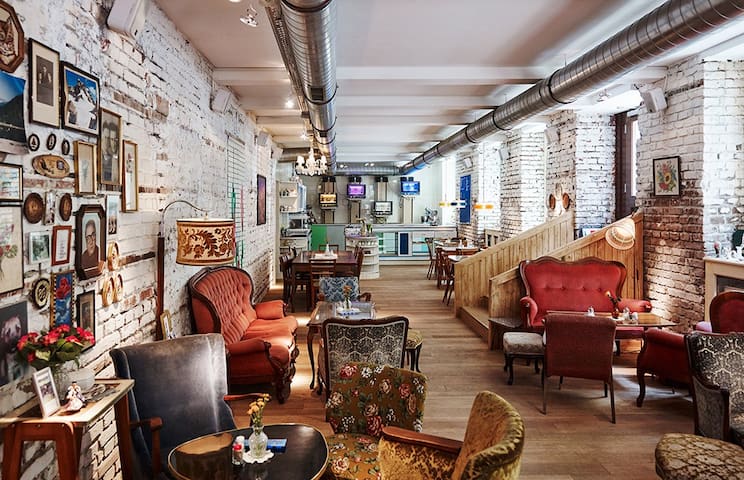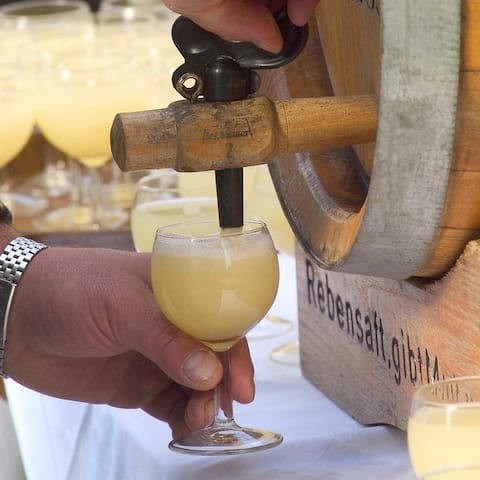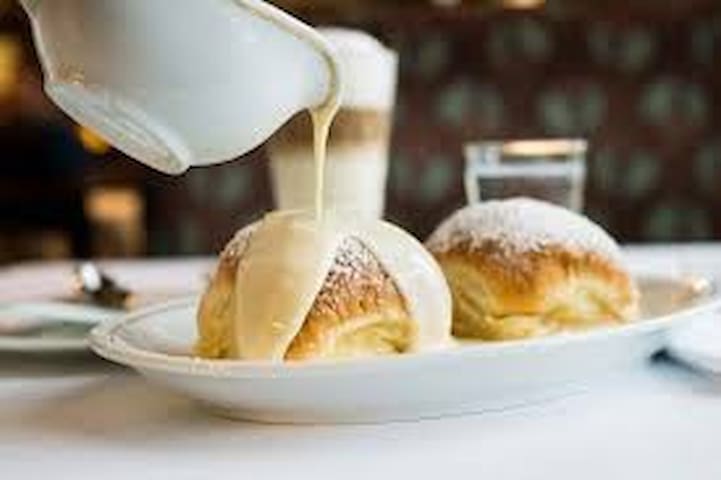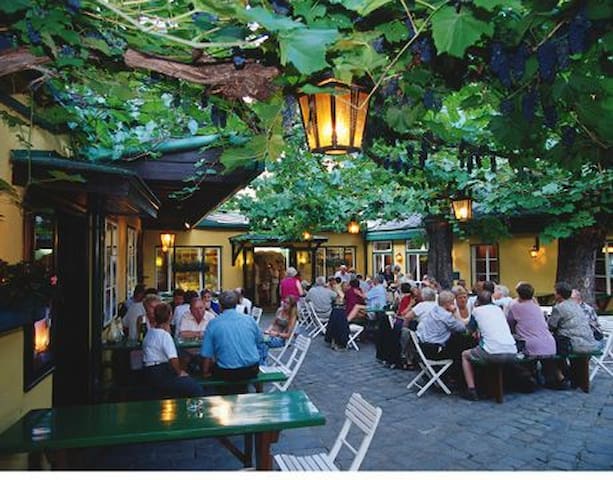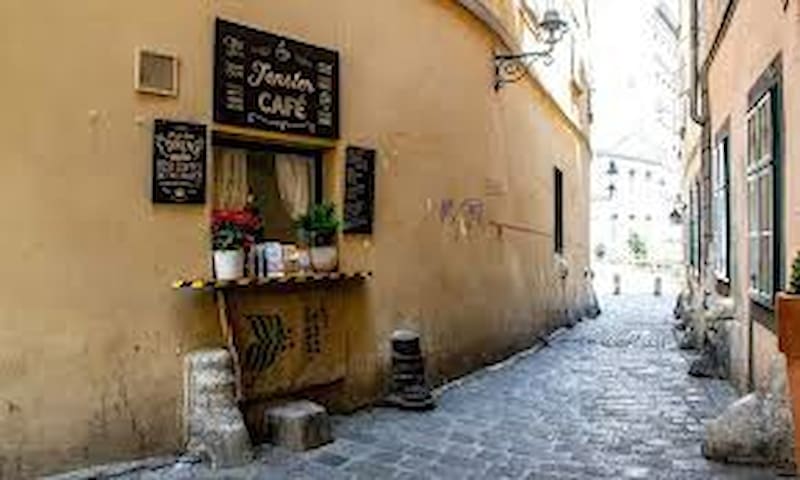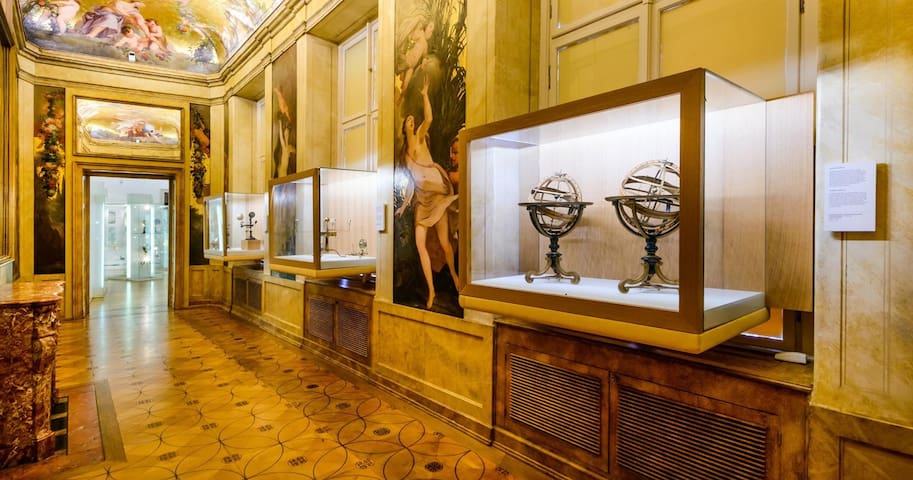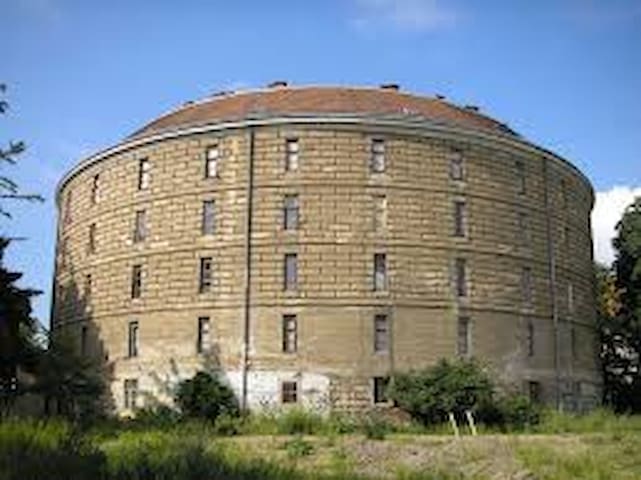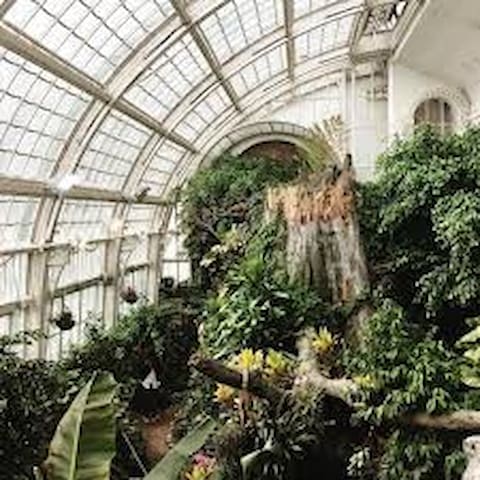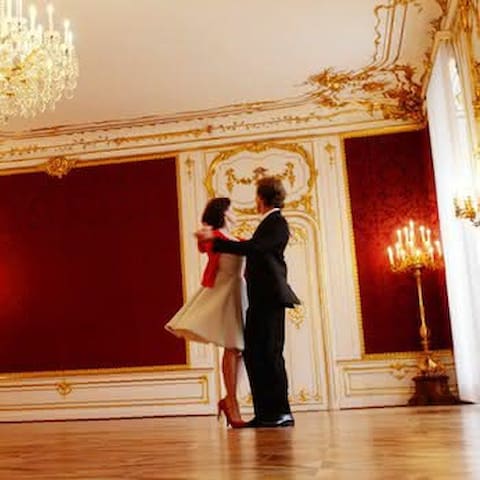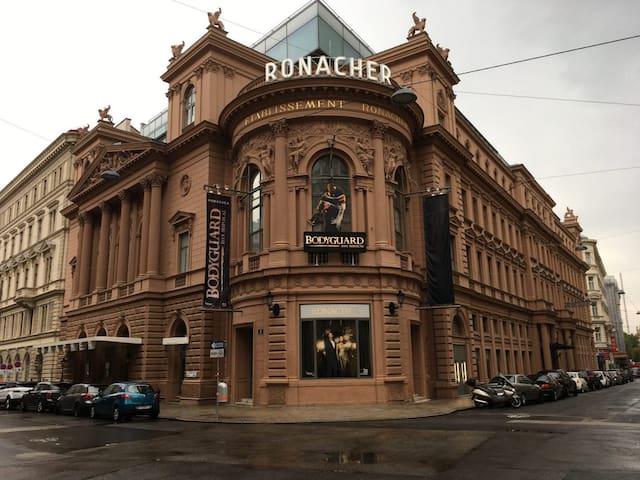Food scene
Das Café Vollpension ist das Café für jung und alt - hier gibt es nicht nur vortreffliche Mehlspeisen, sondern auch allgemein Verpflegung wie von Großmutter.
85 íbúar mæla með
Vollpension
16 SchleifmühlgasseDas Café Vollpension ist das Café für jung und alt - hier gibt es nicht nur vortreffliche Mehlspeisen, sondern auch allgemein Verpflegung wie von Großmutter.
The Genussmeile 2019
Have you ever seen "the longest bar in the world"?
It’s that time again. Along the 1st Vienna water line hiking path between Mödling and Bad Vöslau on the 7th and 8th, 14th and 15th September 2019: Hike, Taste, Enjoy! Around 80 winegrowing enterprises from the Vienna Woods thermal region offer everything that can be made from grapes to sample - and this without entry fee!Hike - Taste - EnjoyMust, Federweisser and wine as well as the typical regional "delicacies" will trigger a real explosion of indulgence when you walk from stand to stand. Catering businesses from the Lower Austrian inn culture and individual regional producers, such as the "Gutes zum Genießen" or "So schmeckt Niederösterreich" associations, also ensure an excellent culinary supply.Follow the charming pathsEnjoyment in connection with the excellent grape products embedded in the unique landscape of the Vienna Woods thermal region make this event particularly appealing. Accompanied by the range of hills of the Vienna Woods, the culinary walk leads directly through the vineyards of the region. You can look forward to entertaining and enjoyable hours along the "longest bar in the world".Opening times of the Genussmeile 2019Saturdays and Sundays from 12:00 hrs until nightfall.
About Sturm:
Fizzy, fruity, and still fermenting, this almost-wine is a celebrated part of Austria's harvest season.
From late September through early October, a dubious-looking drink is popular in Austria. Called sturm, it’s usually poured into a pint glass, tumbler, or large wine glass and has the look of hazy, unfiltered beer. But sturm is actually fermenting grape juice, still on its way to becoming wine, and it’s Austria’s favorite way to celebrate the harvest season.
Usually in winemaking, every part of the process is deliberate and sometimes even a little slow. The fermentation is controlled, done at just the right temperature that the winemaker chooses to bring out exactly the flavors she wants. Wines are aged in tanks or barrels, and all the little bits of grape skin and yeast that are in the grape juice as it ferments settle to the bottom. As the wine is poured into different containers (called racking), it’s poured off this sediment, getting it closer to the clear red, white, or pink beverage we think of when we think of wine.
But wine-producing regions succumb to a little bit of euphoria during harvest season, leading to bacchanal-like behavior and drinks like sturm, where still-fermenting juice is drunk in quantities large enough that it sometimes leads to singing.
The best place to sample sturm is at a typically Austrian-style restaurant called a heuriger. Heurigen are sort of like the wine version of brewpubs. They are small, family-owned wineries that have a restaurant attached to them, so the wine you drink with your meal was made on the premises. They are casual, homey places, and some of them even have buffets instead of regular table service. Sometimes you can even watch wine being made while you eat if your table is outside and you’re at the right angle.
If you’re already in Vienna during sturm season, Döbling, Vienna’s 19th district, is home to the densest concentration of heurigen so you can sample a few different types of sturm and see which you like the best. Some are made with red grapes, although most is made with white, and some are sweeter than others. They all share a fresh, juicy, slightly fizzy quality, and are definitely meant more for gulping than pondering, swirling and sniffing.
Need to Know
One drawback to sturm is that it can’t really be stored. Because it’s still fermenting, and rapidly at that, the beverage is still creating carbon dioxide. If it’s capped tightly or corked, it would cause the bottle to explode. Winemakers have created a short-term storage solution by using special caps with holes in them, but that only works for a couple of days. Usually just a bit of foil is used to cover the bottles and keep fruit flies out. But even with these workarounds, sturm should be drunk fresh.
https://www.thermenregion-wienerwald.at/en/the-genussmeile
Where: You can take the train from Wien Hauptbahnhof to Gumpoldskirchen it's direct and only takes 30min
12 íbúar mæla með
Gumpoldskirchen
The Genussmeile 2019
Have you ever seen "the longest bar in the world"?
It’s that time again. Along the 1st Vienna water line hiking path between Mödling and Bad Vöslau on the 7th and 8th, 14th and 15th September 2019: Hike, Taste, Enjoy! Around 80 winegrowing enterprises from the Vienna Woods thermal region offer everything that can be made from grapes to sample - and this without entry fee!Hike - Taste - EnjoyMust, Federweisser and wine as well as the typical regional "delicacies" will trigger a real explosion of indulgence when you walk from stand to stand. Catering businesses from the Lower Austrian inn culture and individual regional producers, such as the "Gutes zum Genießen" or "So schmeckt Niederösterreich" associations, also ensure an excellent culinary supply.Follow the charming pathsEnjoyment in connection with the excellent grape products embedded in the unique landscape of the Vienna Woods thermal region make this event particularly appealing. Accompanied by the range of hills of the Vienna Woods, the culinary walk leads directly through the vineyards of the region. You can look forward to entertaining and enjoyable hours along the "longest bar in the world".Opening times of the Genussmeile 2019Saturdays and Sundays from 12:00 hrs until nightfall.
About Sturm:
Fizzy, fruity, and still fermenting, this almost-wine is a celebrated part of Austria's harvest season.
From late September through early October, a dubious-looking drink is popular in Austria. Called sturm, it’s usually poured into a pint glass, tumbler, or large wine glass and has the look of hazy, unfiltered beer. But sturm is actually fermenting grape juice, still on its way to becoming wine, and it’s Austria’s favorite way to celebrate the harvest season.
Usually in winemaking, every part of the process is deliberate and sometimes even a little slow. The fermentation is controlled, done at just the right temperature that the winemaker chooses to bring out exactly the flavors she wants. Wines are aged in tanks or barrels, and all the little bits of grape skin and yeast that are in the grape juice as it ferments settle to the bottom. As the wine is poured into different containers (called racking), it’s poured off this sediment, getting it closer to the clear red, white, or pink beverage we think of when we think of wine.
But wine-producing regions succumb to a little bit of euphoria during harvest season, leading to bacchanal-like behavior and drinks like sturm, where still-fermenting juice is drunk in quantities large enough that it sometimes leads to singing.
The best place to sample sturm is at a typically Austrian-style restaurant called a heuriger. Heurigen are sort of like the wine version of brewpubs. They are small, family-owned wineries that have a restaurant attached to them, so the wine you drink with your meal was made on the premises. They are casual, homey places, and some of them even have buffets instead of regular table service. Sometimes you can even watch wine being made while you eat if your table is outside and you’re at the right angle.
If you’re already in Vienna during sturm season, Döbling, Vienna’s 19th district, is home to the densest concentration of heurigen so you can sample a few different types of sturm and see which you like the best. Some are made with red grapes, although most is made with white, and some are sweeter than others. They all share a fresh, juicy, slightly fizzy quality, and are definitely meant more for gulping than pondering, swirling and sniffing.
Need to Know
One drawback to sturm is that it can’t really be stored. Because it’s still fermenting, and rapidly at that, the beverage is still creating carbon dioxide. If it’s capped tightly or corked, it would cause the bottle to explode. Winemakers have created a short-term storage solution by using special caps with holes in them, but that only works for a couple of days. Usually just a bit of foil is used to cover the bottles and keep fruit flies out. But even with these workarounds, sturm should be drunk fresh.
https://www.thermenregion-wienerwald.at/en/the-genussmeile
Where: You can take the train from Wien Hauptbahnhof to Gumpoldskirchen it's direct and only takes 30min
Try Cafe Hawelka: Delicious Buchteln
These pull-apart rolls were once baked with lottery tickets in the center.
In Austria, pull-apart rolls known as buchteln often house a dollop of plum or apricot preserves. But throughout history, bakers have studded the center of these brioche-like buns with various ingredients, from squares of chocolate to poppyseed paste to lottery tickets. During the Biedermeier era of the 19th century, a time during which Europe’s middle class expanded considerably, buchteln were referred to as “lotteries” because of their play-to-win filling.
Though the yeasty treat originated in the Bohemia region of Czechia, today, Austrians consider the warm, fruit-filled style—often served fresh from the oven—a local classic. Bakers press jam in the middle, then place the dough side-by-side to create the finished bread’s pull-apart effect. Home cooks also turn plain, unfilled buchteln into a decadent dessert by serving them in a pool of vanilla cream. The fluffy rolls absorb whatever sauce they touch, so it’s best to avoid attempting this style with the ticket-filled version.
102 íbúar mæla með
Café Hawelka
6 DorotheergasseTry Cafe Hawelka: Delicious Buchteln
These pull-apart rolls were once baked with lottery tickets in the center.
In Austria, pull-apart rolls known as buchteln often house a dollop of plum or apricot preserves. But throughout history, bakers have studded the center of these brioche-like buns with various ingredients, from squares of chocolate to poppyseed paste to lottery tickets. During the Biedermeier era of the 19th century, a time during which Europe’s middle class expanded considerably, buchteln were referred to as “lotteries” because of their play-to-win filling.
Though the yeasty treat originated in the Bohemia region of Czechia, today, Austrians consider the warm, fruit-filled style—often served fresh from the oven—a local classic. Bakers press jam in the middle, then place the dough side-by-side to create the finished bread’s pull-apart effect. Home cooks also turn plain, unfilled buchteln into a decadent dessert by serving them in a pool of vanilla cream. The fluffy rolls absorb whatever sauce they touch, so it’s best to avoid attempting this style with the ticket-filled version.
Have coffee in a greenhouse!
Part of the huge Hofburg complex in the heart of the city is an Art Nouveau greenhouse – the Palmenhouse. It is the former home of Habsburg royal family that now houses the residence of Austria’s President and the Prime Minister’s office.
And the Butterflyhouse. Once used by the emperor as a place of relaxation, it contains the Schmetterlinghouse (Butterflyhouse).
It is a beautiful display of hundreds of butterfly species living in a large tropical rainforest setting.
161 íbúar mæla með
Palmenhaus
1 BurggartenHave coffee in a greenhouse!
Part of the huge Hofburg complex in the heart of the city is an Art Nouveau greenhouse – the Palmenhouse. It is the former home of Habsburg royal family that now houses the residence of Austria’s President and the Prime Minister’s office.
And the Butterflyhouse. Once used by the emperor as a place of relaxation, it contains the Schmetterlinghouse (Butterflyhouse).
It is a beautiful display of hundreds of butterfly species living in a large tropical rainforest setting.
Go For a Walk and Dinner in Grinzing
You probably don’t know that Vienna is the only metropolis with significant vineyard operations within the city limits.
The wine taverns in Vienna are named “Heurige” and are located in charming neighborhoods that have maintained their village character. These areas are easily accessible by public transport from the city center and they border the Vienna Woods, a UNESCO Biosphere Reserve with clearly marked walking and hiking routes.
Grinzing is the most famous of the Viennese wine villages, is reachable from the Schottentor station in the city center via tram line number 38. Heuriger restaurants are everywhere in Grinzing and you can enjoy new wine (the one from the current vintage also named “heurige”), assorted food platters, live music, and good cheer
But before you visit one of these restaurants you can work up an appetite by hiking to Kahlenberg or the Leopoldsberg. Although tiny for everybody else’s standards except for the locals’, Vienna’s most famous hills allow for enchanting vistas over the city and the Danube basin as far as Bratislava.
If you’re on the lazy side, bus number 38A takes you from Grinzing to the top of the hills such that you can walk your way back through astonishing panoramas, vine covered slopes, and more Heuriger hidden among vineyards. Finally, for the super lazy ones, the Vienna Heurigen Express offers a round trip of the area in a hop on hop off system, so you can enjoy the charming villages and views without too much effort.
65 íbúar mæla með
Grinzing
Go For a Walk and Dinner in Grinzing
You probably don’t know that Vienna is the only metropolis with significant vineyard operations within the city limits.
The wine taverns in Vienna are named “Heurige” and are located in charming neighborhoods that have maintained their village character. These areas are easily accessible by public transport from the city center and they border the Vienna Woods, a UNESCO Biosphere Reserve with clearly marked walking and hiking routes.
Grinzing is the most famous of the Viennese wine villages, is reachable from the Schottentor station in the city center via tram line number 38. Heuriger restaurants are everywhere in Grinzing and you can enjoy new wine (the one from the current vintage also named “heurige”), assorted food platters, live music, and good cheer
But before you visit one of these restaurants you can work up an appetite by hiking to Kahlenberg or the Leopoldsberg. Although tiny for everybody else’s standards except for the locals’, Vienna’s most famous hills allow for enchanting vistas over the city and the Danube basin as far as Bratislava.
If you’re on the lazy side, bus number 38A takes you from Grinzing to the top of the hills such that you can walk your way back through astonishing panoramas, vine covered slopes, and more Heuriger hidden among vineyards. Finally, for the super lazy ones, the Vienna Heurigen Express offers a round trip of the area in a hop on hop off system, so you can enjoy the charming villages and views without too much effort.
Dine With a Panoramic View at the Danube Tower
The Danube Tower (Donauturm) is Austria’s highest landmark, situated in the Danube Park and visible from afar. Constructed in the 1960’s for the Viennese International Horticultural Show, it has recently been renovated in a modern reinterpretation of the original style.
Visitors can take the express lift to the viewing terrace 150m above ground that presents an arresting 360° panorama over the entire city. One floor higher is the Tower Café offering the full traditional Viennese coffee house experience in this unique setting.
One of our favorite things to do in Vienna during weekends is to enjoy brunch in the Tower Café. Go even higher, and at 170m you find the Tower Restaurant, an excellent blend of Austrian cuisine, wine, and hospitality. The restaurant rotates, thus enabling guests a changing 360° scenic view over Vienna during the dinner.
Family events can be celebrated at the Danube Tower, or you can book special meals in a romantic setting, such as the monthly full moon dinner package.
6 íbúar mæla með
Wien Donauturm station
Dine With a Panoramic View at the Danube Tower
The Danube Tower (Donauturm) is Austria’s highest landmark, situated in the Danube Park and visible from afar. Constructed in the 1960’s for the Viennese International Horticultural Show, it has recently been renovated in a modern reinterpretation of the original style.
Visitors can take the express lift to the viewing terrace 150m above ground that presents an arresting 360° panorama over the entire city. One floor higher is the Tower Café offering the full traditional Viennese coffee house experience in this unique setting.
One of our favorite things to do in Vienna during weekends is to enjoy brunch in the Tower Café. Go even higher, and at 170m you find the Tower Restaurant, an excellent blend of Austrian cuisine, wine, and hospitality. The restaurant rotates, thus enabling guests a changing 360° scenic view over Vienna during the dinner.
Family events can be celebrated at the Danube Tower, or you can book special meals in a romantic setting, such as the monthly full moon dinner package.
Delve Into Vienna’s Third Wave Coffee Culture
Right in the heart of the city, the Fenster Café is exactly what the name says – a Window Coffee Place – that serves the most affordable espresso in Vienna for 0,99 cents, coffee in a chocolate-covered ice cream cone, and a wide range of other specialties – to go!
Before opening their second shop in the famous Ferstel Passage in the city center, CaffèCouture have been around in Vienna for over five years and have gained the appreciation of the locals with their know-how and passion. Enjoy!
I have saved our personal favorite for last – hidden pretty much behind the famous Karlskirche, Kaffefabrik is a small neighborhood coffee shop that has won our hearts. Their coffee is made from freshly roasted beans they acquire themselves from farmers in Africa, India, and South America.
12 íbúar mæla með
Fenster Cafe
10 GriechengasseDelve Into Vienna’s Third Wave Coffee Culture
Right in the heart of the city, the Fenster Café is exactly what the name says – a Window Coffee Place – that serves the most affordable espresso in Vienna for 0,99 cents, coffee in a chocolate-covered ice cream cone, and a wide range of other specialties – to go!
Before opening their second shop in the famous Ferstel Passage in the city center, CaffèCouture have been around in Vienna for over five years and have gained the appreciation of the locals with their know-how and passion. Enjoy!
I have saved our personal favorite for last – hidden pretty much behind the famous Karlskirche, Kaffefabrik is a small neighborhood coffee shop that has won our hearts. Their coffee is made from freshly roasted beans they acquire themselves from farmers in Africa, India, and South America.
Sightseeing
Handsomely crafted representations of our round planet.
Until the 19th century, globes often came as a pair—a world globe and a matching celestial globe. One can’t help but observe the admirable craft and beauty that was once devoted to these small representations of our world. To visit the Globe Museum is to step back into a time when all things, including scientific instruments, were made with care and artistry. There is no better way to explore the ways in which man’s understanding of the earth and the heavens has changed over hundreds of years of exploration and study.
The world’s only public museum dedicated solely to globes contains an astonishing collection. (The Maritime Museum in Greenwich, England, also has an extensive globe collection.) There are folding fabric globes (which were inflated with a bellows), giant man-sized globes, and tiny plum-sized globes, each exquisitely made with dark wood, fine lines, and rich colors.
Some of the most interesting items in the museum are the brass tellurions. A tellurion is a mechanical demonstration of the earth’s movement about its axes, consisting of a long arm at the end of which is a small rotating globe with a moon spinning around it. At the other end of the arm is a charmingly simple sun: a candle and a brass reflecting disc. With a turn of the crank, the system comes alive. As the earth and moon spin, the tellurion shows seasons, eclipses, tides, precessions of the equinox, and other astronomical phenomena.
14 íbúar mæla með
Globe Museum of the Austrian National Library
9 HerrengasseHandsomely crafted representations of our round planet.
Until the 19th century, globes often came as a pair—a world globe and a matching celestial globe. One can’t help but observe the admirable craft and beauty that was once devoted to these small representations of our world. To visit the Globe Museum is to step back into a time when all things, including scientific instruments, were made with care and artistry. There is no better way to explore the ways in which man’s understanding of the earth and the heavens has changed over hundreds of years of exploration and study.
The world’s only public museum dedicated solely to globes contains an astonishing collection. (The Maritime Museum in Greenwich, England, also has an extensive globe collection.) There are folding fabric globes (which were inflated with a bellows), giant man-sized globes, and tiny plum-sized globes, each exquisitely made with dark wood, fine lines, and rich colors.
Some of the most interesting items in the museum are the brass tellurions. A tellurion is a mechanical demonstration of the earth’s movement about its axes, consisting of a long arm at the end of which is a small rotating globe with a moon spinning around it. At the other end of the arm is a charmingly simple sun: a candle and a brass reflecting disc. With a turn of the crank, the system comes alive. As the earth and moon spin, the tellurion shows seasons, eclipses, tides, precessions of the equinox, and other astronomical phenomena.
This former insane asylum now holds a pathological anatomy museum.
Meaning “Fools’ Tower,” the Narrenturm was one of the first insane asylums ever built. Today the Narrenturm no longer holds mentally imbalanced Viennese, but it does contain something else of interest: The Anatomical-Pathological Museum.
While the circular building (known by locals as “the poundcake”) houses only a small percent of the museum’s total collection, it contains some fascinating pieces. Syphilitic skulls that resemble Swiss cheese, jars of disfigured fetuses, and graphic wax displays of untreated STDs all peer out at you from the old cells. It also contains a recreated wonder cabinet, complete with a narwhal tusk and taxidermied monkeys.
Keep your eyes open for the Hydrocephalic skeleton, towards the end of the museum. His enormous head is hard to miss.
Update August 2017: The building is undergoing a major renovation and much of the collection has been moved into storage.
17 íbúar mæla með
Pathologisch-anatomische Sammlung im Narrenturm des NHM Wien
2 SpitalgasseThis former insane asylum now holds a pathological anatomy museum.
Meaning “Fools’ Tower,” the Narrenturm was one of the first insane asylums ever built. Today the Narrenturm no longer holds mentally imbalanced Viennese, but it does contain something else of interest: The Anatomical-Pathological Museum.
While the circular building (known by locals as “the poundcake”) houses only a small percent of the museum’s total collection, it contains some fascinating pieces. Syphilitic skulls that resemble Swiss cheese, jars of disfigured fetuses, and graphic wax displays of untreated STDs all peer out at you from the old cells. It also contains a recreated wonder cabinet, complete with a narwhal tusk and taxidermied monkeys.
Keep your eyes open for the Hydrocephalic skeleton, towards the end of the museum. His enormous head is hard to miss.
Update August 2017: The building is undergoing a major renovation and much of the collection has been moved into storage.
Schmetterlinghaus: The Imperial Butterfly Park
A tropical paradise just a short trip from the opera house, filled with beautiful winged creatures for your enjoyment.
Built around the turn of the last century and part of the Hofburg palace, this “Jugendstil” greenhouse is filled with a lush, tropical landscape, trickling waterfalls, and within its humid walls you will be treated to its delicate inhabitants - the butterflies.
Peeking into hollow trees and up among the branches, you can watch the graceful favorites of the bug world flitter and fly, or softly rest and pulse their exotic wings, possibly on your outstretched finger. A closer look could very well uncover cocoons, or you may even catch a hatching.
A short film at the end of your walk though the butterfly habitat will give you some scientific insight on the ethereal creatures you just enjoyed inside the tropical forest in the center of a city.
7 íbúar mæla með
Schmetterlinghaus
Schmetterlinghaus: The Imperial Butterfly Park
A tropical paradise just a short trip from the opera house, filled with beautiful winged creatures for your enjoyment.
Built around the turn of the last century and part of the Hofburg palace, this “Jugendstil” greenhouse is filled with a lush, tropical landscape, trickling waterfalls, and within its humid walls you will be treated to its delicate inhabitants - the butterflies.
Peeking into hollow trees and up among the branches, you can watch the graceful favorites of the bug world flitter and fly, or softly rest and pulse their exotic wings, possibly on your outstretched finger. A closer look could very well uncover cocoons, or you may even catch a hatching.
A short film at the end of your walk though the butterfly habitat will give you some scientific insight on the ethereal creatures you just enjoyed inside the tropical forest in the center of a city.
Whether or not the State Hall of the Austrian National Library is an off the beaten path attraction is debatable, seeing as it is probably the most famous library hall in the whole world. The previous court library of the Habsburgs, decorated in a lavishing baroque style, is 20 metres high and 80 metres long, and houses over 200,000 volumes.
To make it even more majestic are the central 30 metres high oval dome, allegorical frescoes, and four Venetian globes each more than one meter in diameter. It does not matter if you are a book and art lover or not, a visit to this landmark should be on your list of things to do in Vienna during your next visit.
81 íbúar mæla með
Þjóðarbókasafn Austurríkis
1 JosefsplatzWhether or not the State Hall of the Austrian National Library is an off the beaten path attraction is debatable, seeing as it is probably the most famous library hall in the whole world. The previous court library of the Habsburgs, decorated in a lavishing baroque style, is 20 metres high and 80 metres long, and houses over 200,000 volumes.
To make it even more majestic are the central 30 metres high oval dome, allegorical frescoes, and four Venetian globes each more than one meter in diameter. It does not matter if you are a book and art lover or not, a visit to this landmark should be on your list of things to do in Vienna during your next visit.
afternoon blitz courses
LEARN HOW TO WALTZ
You don't have to be Viennese to attend interminable weekly dance classes to master the Viennese waltz. The basics of the famous dance are as commonly practiced as the habit of taking a glass of water with your coffee. In Vienna, we always drink water with coffee.
Most dance schools in the city offer afternoon blitz courses. If you are passing by be sure to join in, you may be ready for the next Viennese Ball.
Local Tip: If you are in the city on the 11.11 at 11.11 o’clock you can practice your waltzing skills in the streets.
NOVEMBER 11 AT 11:11
November 11 is the official opening of the ball season, meaning the entire pedestrian area around the Stephansplatz turns into a ballroom. The square is located in front of the Stephansdom cathedral and the two pedestrian arteries (Graben and Kärntner Straße) are filled with people dancing in full formal attire wearing bow ties and white dresses.
The same happens on New Year’s Eve, but in a more relaxed atmosphere. Basically, the Viennese are always happy to put on a show in formal attire. Everybody is welcome to join.
Blitz Dance Lessons no reservations:
Rueff Dance School
Friedrich-Schmidt-Platz 4, 1080 Wien
www.tanzschulerueff.at
+43 1 405 26 69
Friedrich-Schmidt-Platz 4
4 Friedrich-Schmidt-PlatzLEARN HOW TO WALTZ
You don't have to be Viennese to attend interminable weekly dance classes to master the Viennese waltz. The basics of the famous dance are as commonly practiced as the habit of taking a glass of water with your coffee. In Vienna, we always drink water with coffee.
Most dance schools in the city offer afternoon blitz courses. If you are passing by be sure to join in, you may be ready for the next Viennese Ball.
Local Tip: If you are in the city on the 11.11 at 11.11 o’clock you can practice your waltzing skills in the streets.
NOVEMBER 11 AT 11:11
November 11 is the official opening of the ball season, meaning the entire pedestrian area around the Stephansplatz turns into a ballroom. The square is located in front of the Stephansdom cathedral and the two pedestrian arteries (Graben and Kärntner Straße) are filled with people dancing in full formal attire wearing bow ties and white dresses.
The same happens on New Year’s Eve, but in a more relaxed atmosphere. Basically, the Viennese are always happy to put on a show in formal attire. Everybody is welcome to join.
Blitz Dance Lessons no reservations:
Rueff Dance School
Friedrich-Schmidt-Platz 4, 1080 Wien
www.tanzschulerueff.at
+43 1 405 26 69
Theatre
Savor a Musical at Ronacher Theater
I am pretty sure than when you think about things to do in Vienna you might rightfully consider a classical concert or an evening at the opera/ballet as a priority.
You can have the traditional Viennese experience in one day, leaving you with enough time to experiment further. So how about a Broadway level musical for a change?
The Ronacher has a long tradition as a vaudeville and variety theater, and has been known to compete with the more high end establishments since the 19th century. The theater building itself (located in the historic first district) recently underwent extensive renovation works well worth checking out.
28 íbúar mæla með
Ronacher
9 HimmelpfortgasseSavor a Musical at Ronacher Theater
I am pretty sure than when you think about things to do in Vienna you might rightfully consider a classical concert or an evening at the opera/ballet as a priority.
You can have the traditional Viennese experience in one day, leaving you with enough time to experiment further. So how about a Broadway level musical for a change?
The Ronacher has a long tradition as a vaudeville and variety theater, and has been known to compete with the more high end establishments since the 19th century. The theater building itself (located in the historic first district) recently underwent extensive renovation works well worth checking out.

